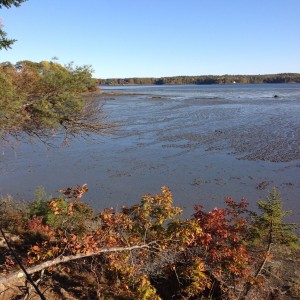Every month, I drive over to town hall and join 4 or 5 other “commissioners” to learn what conservation issues are afoot in our town and offer opinion or, at times, decision on some of them. It’s a volunteer position to which I was appointed by the town council after submitting my resume and having a 15-minute interview. Most of our work involves review of development plans and easements, with an eye toward how they will apportion and protect conserved land. Or how our town will work with land already conserved and managed by the town. And, though we sit behind official nameplates and are televised on local cable, (where, reportedly, we are watched by some coterie of citizens), our meetings tend toward the quiet.
This week, however, brought a little noisy incandescence to our early evening gathering. Under discussion was a development to be sited on a point that juts out into our nearby, muddy bay. The 4 houses have been planned for nearly 20 years, and approved that long ago, so, despite that lag, they were not the issue. What drew our attention, or, more accurately, drew public comment that focused our attention, was the delicate question of erosion of the soft bluffs along the point and the “hardening” proposed to block that erosion.
Rip-rapping, the dumping and/or positioning of stone, is common practice along the coast, where those who own land look warily at the sea. The sea is, of course, a primary reason why coastliners want to live where they do, but its relationship with land seems often like that of predator and prey. Waves, the ocean’s teeth when stirred by storm, can and do simply gnash land (and dwellings) away.
On a point such as the one under discussion this week – well up the bay and protected from severe storm effects by islands and mudflats – the gnawing away of land is a slow, seemingly gentle, practice. Still, even a cursory glance shows the way repeated rubbings of tide and current can add up to a lot of loss. A little seaside path along the 30-foot high bluff on the point’s east flank illustrates this action: in the ten years I’ve walked this area, erosion’s taken enough of the bluff to drop trees into the sea and force the path 15 feet inland. Left to their own rhythms, sea and bluff would dance slowly inland across this point, perhaps cutting it off entirely in a century or so.
But, of course, we like our houses and landscapes to suggest permanence, even as that’s the last possibility on life’s list. And so: hardening of coast against change; and so: mild controversy at our meeting. Should rip-rap-rock be allowed? Those who would build the four houses say, yea, of course. They want the appearance of bluff security. Careful what you wish/rip-rap for, say others. Studies of coastal erosion show that often hardened coastline in one spot simply shifts erosion to the softer flanks of that hardening; the currents and tides, even the gentle ones up bay, will find a way. They will gnaw what they will gnaw.
Then, there is the possibility of unintended effect on the mudflats surrounding the point. These flats, extensive at low tide, are rich with shellfish; they are fished by clammers who depend for their living upon their consistency. Might the change in point stability affect these flats, either through redirected silt, of via redirected runoff? It’s happened elsewhere. Might a plague of invasive green crabs, clam-eaters linked too to the warming of our waters, make the rip-rap their residence? That too has happened elsewhere. So many pointed questions. To which we will return in January.
All of this would fascinate Henry Thoreau, who walked to his observations, surveyed them closely, measuring often to decimals the works of winds and waters, looking for the stories land and water tell of themselves. Thoreau’s ability to see and tell those stories gets him named often as the father of ecological thinking. For Thoreau, a close look at what was present often allowed him to see back into the past and forward into the future.
When we meet again in January to look at the point proposals, I’ll have walked the land again and tried to see like Henry.






